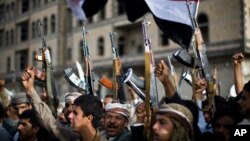The crisis in Yemen began as an internal battle between the Arabian Peninsula country's government and its disillusioned opponents. It looked like a repeat of civil uprisings in Egypt, Libya and Syria. But when reports surfaced that Iran is backing the Houthi rebels, the conflict started to transcend Yemen’s borders.
Now, it verges on a direct conflict between Saudi Arabia and Iran, the two heavyweights in the region - and in the whole Muslim world.
Sunni vs. Shi’ite?
Worried that this clash could engulf other countries with Muslim majority populations, Turkish President Recep Tayyip Erdogan said last week that the Islamic world is at risk of “disintegration” due to the conflicts in the region between the Sunni and Shi’ite strands of the Muslim faith.
Erdogan was referring to Shi’ite-majority Iran and Sunni-majority Saudi Arabia. Both countries allegedly back proxies to advance their agendas in different Muslim countries. In Yemen’s case, Shi’ite Houthi rebels brought down a Sunni ruler, Abd-Rabbu Mansour Hadi. Now, a Saudi-led coalition is conducting an air campaign against the Houthis.
While Iran has not officially said it supports any group in Yemen, it has opposed the intervention of the Saudis and other Middle Eastern states. But this month, U.S. Secretary of State John Kerry said there is evidence that Iran is supplying the Houthis with arms.
Although the largest Muslim populations are in Indonesia, India, Pakistan, Bangladesh and Afghanistan, analysts say the Middle East has an outsized influence in rest of the Muslim world.
“Iran supports Shia factions in Afghanistan and, sometimes, this support is very overt,” says Abdul Ghafoor Liwal of the Regional Studies Center in Afghanistan. “On the other hand, Saudi Arabia and other Sunni Arab countries do not hide their support to some of [the] Sunni organizations,” he told VOA.
Period of change
Some analysts, however, say the Yemen conflict has little to do with the differences between Sunni and Shi’ite Muslims.
“These people are not destroying and killing each other because of their sectarian identities. They are killing each other because of a power struggle in the region and geopolitical issues in the region which have contributed to the problem many decades prior to this,” said Abdullah Antepli, Islamic Studies professor at Duke University in the U.S. state of North Carolina.
Antepli said there is the idea that if discord between the Sunni and Shi’ite believers ended and the religious component of the conflict were resolved, the factions in Yemen would stop killing each other.
“This is absolutely not the case. “[The] media’s over- emphasis on the ethnic aspect of this conflict is grossly underestimating other contributing factors to this bloodshed,” he said.
The factors causing this upheaval in so many Middle Eastern nations, several analysts told VOA, are more complex.
The Muslim world is going through a difficult phase similar to one Europe went through before democracy and respect for rights took deep roots in European societies, said Sharmin Ahmed, co-founder of Minaret of Freedom, a U.S. organization working to educate Muslims and non-Muslims about each other.
“In order to transform the violent expression in the name of religion and ethnicity into harmony and peaceful coexistence, the Muslim world must go through an internal cleansing process of change,” Ahmed said.
No one Muslim world
Some regional and religious scholars challenge the very term “the Muslim world.”
“To me, there is no Muslim world. To assume that there is a monolithic, one-bloc reality called ‘Muslim world’ is very misleading. There are societies which have Muslim majority citizens, but to think that 1.7 billion people could be called one Muslim bloc is misleading,” Duke University’s Antepli said.
Fazil Gazanfaroglu, a member of the Azerbaijani parliament, echoes that view.
“The attitudes of Muslims differ between those of Malaysia and Bangladesh, or between those of Turkey, Azerbaijan and Yemen. Muslims do not have societies which share common principles. Therefore, one cannot discuss disintegration in the first place,” he said.
Some of the scholars, who spoke to VOA, said the ruling class in the Muslim majority countries often advances political and hegemonic agendas in the name of religion or protecting their sects.
Gazanfaroglu says the way to move forward is to become democratic and modern.
“In order to achieve that, the top priorities in these societies must be secular education, development of university mechanism and [a] high level of primary education,” he said.
Bringing social change
While there is no consensus on whether all Muslims should be looked at as belonging to one Muslim world or whether the Muslim world faces the danger of disintegration along sectarian lines because of the crisis in Yemen, many experts stress the need to bring social change to Muslim societies.
Ahmed at Minaret of Freedom said Muslim nations in general pay little attention to human rights and social justice.
“I hope and believe that the current unrest in the Muslim world would be able to usher in a new era of change," she said. "We need to go through the internal purging first. Then, toward embracing the human dignity, social justice and universal core values of love, respect and understanding of one another. And that is Islam.”
Journalists from VOA’s South Asia Division contributed to this report.












